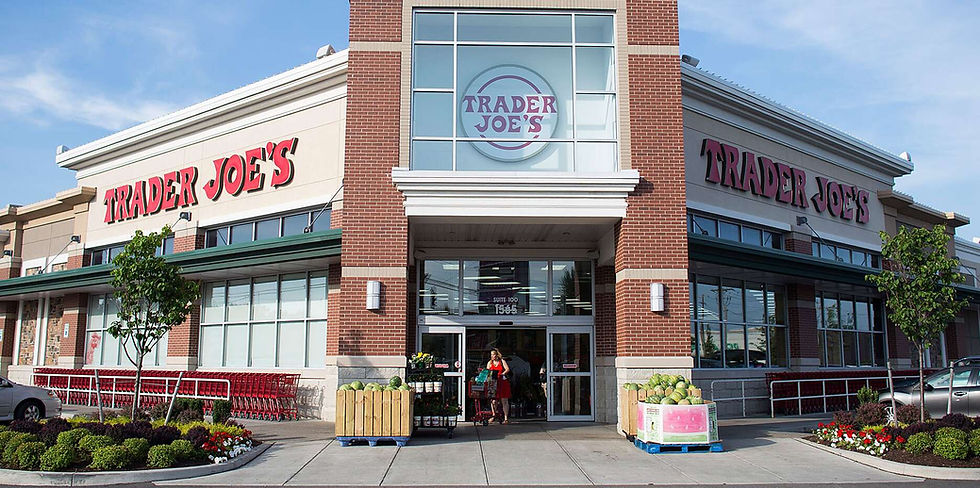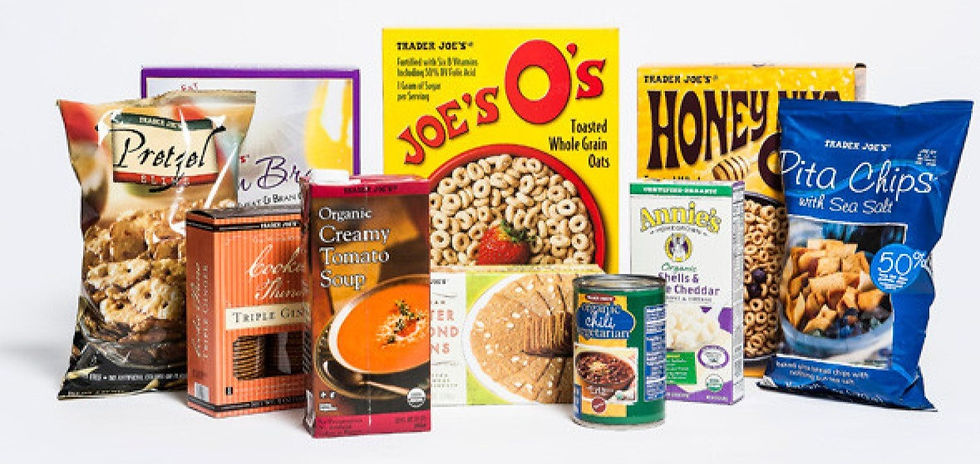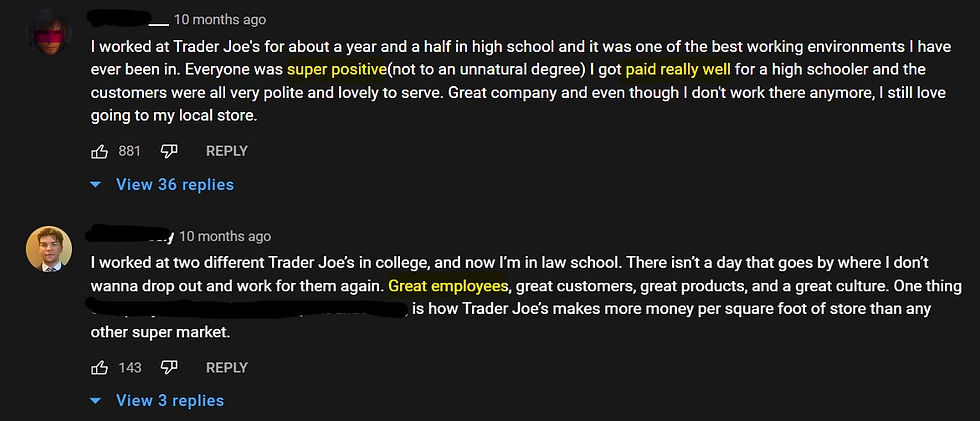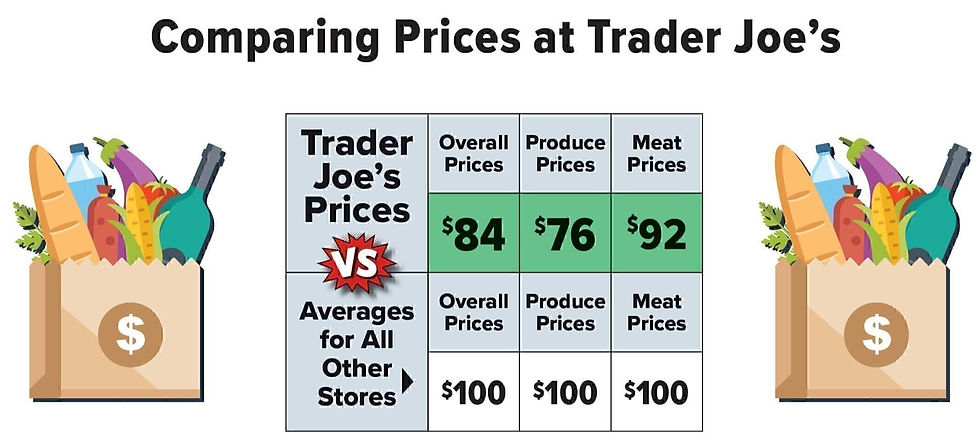Why Trader Joe's is so popular?
- Arshyaa

- Jun 20, 2022
- 5 min read
Trader Joe's is unlike any other major grocery store chain. In this article, we will attempt to identify the unconventional reasons behind their success.

When scrolling social media, some might be surprised to find fan pages for grocery stores. The typical Instagram influencers share beautiful vacation photos and endless selfies, not pasta sauce, and frozen food. But apparently, there is a market for it; customers and creators alike are flocking to social media to share their unique Trader Joe’s grocery finds. With accounts like Trader Joe’s List topping 1.5 million followers.
On YouTube, you will find many videos on ‘Everything New at Trader Joe’s’ lists appearing monthly, and new favorites lists being published on national news sources, the brand has seemingly attracted a cult following. In a sense, the chain has become more than a grocery store; it offers shoppers unique products that become part of customers’ lifestyles.
It has almost a cult following classic thanks to its distinct features, despite not spending on advertising or utilizing social media and other technological advancements. Here's why Trader Joe's became people's favorite grocery store?
Before we move into the discussion, Let's go back a little to when it all began...
History
The first Trader Joe’s store was opened in 1967 in Pasadena, California, by Joe Coulombe, who graduated from Stanford with an MBA. He started off working at Rexall, a popular pharmacy company store that launched five convenient stores (named Pronto) to take advantage of a growing market.

However, the project didn’t do well and was shut down. Coulombe bought the project from them and operated it on his own. Pronto expanded, growing to 18 stores. When 7-Eleven came to California, Joe rebranded, as he did not want to directly compete with the larger, well-established company. Initially, he renamed the store Trader Vic’s, and it grew in popularity because of its employees that wore Hawaiian grass skirts and for giving customers unique foods that regular supermarkets didn’t carry.
Till 1976, the government had laws in place to regulate the price of liquor. This meant that liquor was sold at exceptionally high prices with a larger profit margin. This meant that stores like Trader Joe’s, which sold an assortment of scotch and wine, could afford to sell other products cheaply, as the profits would be made up by their liquor sales.
However, this regulatory apparatus was removed, meaning stores could now lower the prices of liquor. This made things difficult for smaller stores like Trader Joe’s, as bigger supermarkets could afford to bring down prices to a level that smaller stores could not match, taking away profits and customers.

To deal with this problem, in 1979, Coulombe sold the company to a much larger retailer Aldi Nord, owned by Theo Albrecht. Joe stayed on as the chief executive until he retired. In 1989, when he was replaced, the new management kicked up store expansion using the resources of the wealthy Albrecht family, making it the neighborhood Trader Joe’s with over 500 stores that we know today. The Albrecht family owns the company to this date.
Why is it so popular?
Trader Joe’s is different from other grocery stores such as Walmart in its design and products. For starters, it holds no sales, offers no coupons, doesn’t have a loyalty program, doesn’t offer self-checkout, no online ordering, almost no advertising, and doesn’t collect customer data. Here are a few reasons behind its popularity.
Caribbean Theme Store
When opening that first location Joe Column was inspired by the Jungle Cruise ride at Disneyland, a Caribbean vacation that he had just taken, and a book he was reading called White Shadows in the South Seas.
Following the theme, Managers wear bright, casual Hawaiian shirts, sometimes with leis, and are titled, Captains. Assistant managers are designated first mates, and regular employees are called crew. It has a tropical and nautical theme, and unlike other grocery stores, does not display rows and rows of similar-looking branded items.
The employees at Trader Joe's try to get kids involved in grocery shopping by secretly hiding a stuffed animal in each store and you can win a sweet treat if you find it. You can also find a hidden lobster around the store.

The store gives a friendly neighborhood feel and hires local artists to hand-draw its signs and reflect the local culture. The lack of self-checkout, online ordering, and data collection makes customers reminiscent of older times with friendly and knowledgeable staff. Checkout stations have no conveyer belts or TV Screens, and employees use a literal bell instead of a PA system to communicate.
Unique and Fresh Products
Despite a lot of products carrying the Trader Joe label, these are not Trader Joe’s manufactured products. Trader Joe’s strikes a deal with an existing brands such as Pepsi Co, Krafts, Nestle, etc. to puts its label on high-quality, well-liked, and pre-tested foods.
But not all its products are manufactured by large corporations, some of its products are sourced from local farmers or imported from foreign countries. Trader Joe's frozen pizza is famously sourced from Italy, where the company buys pizza from a local family-owned bakery.

In return, the manufacturer gets a new and regular source of income from Trader Joe’s, which will buy in large quantities and pay on delivery, rather than being charged slotting fees. These manufacturers have to sign air-tight NDAs in order to sell there products to Trader Joe's. You can only know about these manufacturer when there is a food recall or a lawsuit.
Good Management
Trader Joe’s staff are especially crucial to the brand name and customer experience, as they hire not based on skill but on personality, recruiting smart, energetic, and conversationalist extroverts. They prioritize the customer, offering immediate assistance when asked, and helping with activities such as dropping groceries in the car. Staff is specifically told to stock products throughout the day, as this initiates close contact with customers.

You'll see many positive feedbacks from former employees of Trader Joe's. The above posts can be found in many online forums and comment sections. Trader Joe's also ranks as the best grocery chain to work. Wages are also better compared to Walmart and Target.
Low-Cost Items
Privately labeled products are cheaper than similar products sold in other grocery stores. Buying a reduced variety in bulk that is marketed and sold as cheap and unique, is one of their cost-cutting strategies. Advertising using their flyer by using non-copyrighted images is another cost-cutting tactic.

These are measures that enable their small stores to keep prices low. Trader Joe’s products have also often found to be almost identical to branded products, despite being sold at a much cheaper price. This makes Trader Joe’s well-known for its cheap, reliable, and unique products, due to its smart selection and positioning of products.
Less is More?
The downside to this method is that Trader Joe’s has a much smaller inventory (around 4,000) compared to other grocery stores, such as Whole Foods Market (around 40,000).
The meticulous management of inventory means that products and arrangements come and go, and customers might often find their favorite items discontinued or out of stock. As Trader Joe’s purchases directly from manufacturers, trucks deliver new stock to their small back rooms, making it difficult to predict demand daily.

People have made pages to inform shoppers which Trader Joe's products are discontinued and where can they get sometimes the same or similar products. The fact that their favorite product in the store can be discounted anytime gets a lot of hate. But this also pushes the shopper to buy their favorite product in bulk. For more: Why you spend so much money at Trader Joe's.
Trader Joe’s policy of ‘Less is More’ has served them well to this point, resulting in a slow but steady growth rate, and a loyal consumer base. It has grown a lot since its modest beginnings as a single store in Pasadena, California.
Their unique marketing strategy, cost-cutting operational efficiency, and strategically designed shopping experience for customers all make it the successful store it is today. Its establishment as a cult brand makes its future growth prospects safe for the foreseeable future. Even today, Trade Joe’s is expanding and establishing more stores across America.









Comments